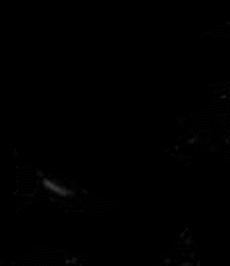Emily Lakdawalla • Jan 28, 2010
Cassini Aegaeon and Prometheus awesomeness
There were many, many treats waiting on the Cassini raw images website this morning. Yesterday, Cassini traversed the G ring, taking photos all the way. While doing so the spacecraft passed within 13,000 kilometers of Aegaeon, the tiny, recently discovered moon that is now believed to be the parent body of the G ring. (Small meteorite impacts onto Aegaeon would toss up dust particles that would escape the little moon's almost nonexistent gravity and go into their own orbits around Saturn; various sorts of drag extend the dust from Aegaeon's neighborhood all the way around the planet, but it's densest near the moon.) That distance is relatively close -- close enough for Cassini to get a very respectable 80 meters per pixel or so on the moon -- but since the moon's only roughly 500 meters across, you're only looking at 5 or 10 pixels.

A better estimate of Aegaeon's size will probably be the most important result of this observation. This little animation cycles through 17 narrow-angle camera frames that Cassini captured on Aegaeon, which flicker because they are taken with different exposure times and through different filters. The moon appears longer and skinnier in the first shots and rounder in the last ones. I would guess (but don't know for sure) that that means that Cassini was closer in the first frames, and saw Aegaeon at a higher phase (half moon like), and farther away in the last frames, and saw Aegaeon at a lower phase (more "full"). The science team will be able to do crafty tricks with these images to arrive at a decent model for Aegaeon's shape and size; I'll keep my eyes peeled for published numbers!
Here's a wide-angle shot showing Aegaeon in context with the G ring (and lots of stars and cosmic ray hits. I've sent a query into someone on the team about why there are more cosmic ray hits in the bottom part of the image than the rest of it.)

The Prometheus images were taken from about three times the distance of the Aegaeon photos, but Prometheus is much bigger than Aegaeon (about 119 by 87 by 61 kilometers in diameter). Here are three clear-filter views. It's fun to compare these to the other high-res photos that Cassini took of Prometheus just a month ago.

But wait, what's that in the uppermost view? There's a stripe crossing Prometheus. It's even more evident in this color composite.

It's not my best work ever on a color Cassini image, because I was in a bit of a hurry, but it's good enough to show something really cool. There are some color fringes in the image where the individual color frames do not align properly. Some of this misalignment is due to Cassini's and Prometheus' relative motions and Prometheus' rotation. A separate issue causes the two rainbows crossing Prometheus' sunlit disk: these are shadows from two tendrils of the F ring, which moved across Prometheus' face in the time separating the images. Neato!!
Visit the raw images website; there's more fun stuff to be had, including Enceladus plume images like this one, Dione closeups like this one, and red, green, and blue frames for a new true-color portrait of Saturn. This mission keeps on delivering great images, month after month!
Support our core enterprises
Your support powers our mission to explore worlds, find life, and defend Earth. You make all the difference when you make a gift. Give today!
Donate

 Explore Worlds
Explore Worlds Find Life
Find Life Defend Earth
Defend Earth

